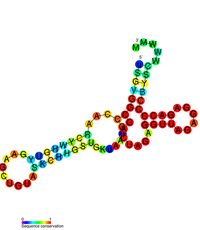Flavivirus
| Flavivirus | |
|---|---|
 |
|
| A TEM micrograph of the yellow fever virus | |
| Virus classification | |
| Group: | Group IV ((+)ssRNA) |
| Family: | Flaviviridae |
| Genus: | Flavivirus |
| Type species | |
|
Yellow fever virus |
|
| Species | |
|
(see list in article) |
|
| Flavivirus 3'UTR stem loop IV | |
|---|---|

Predicted secondary structure of the Flavivirus 3'UTR stem loop IV
|
|
| Identifiers | |
| Symbol | Flavivirus_SLIV |
| Rfam | RF01415 |
| Other data | |
| RNA type | Cis-reg |
| Domain(s) | Flaviviridae |
| SO | 0005836 |
| Flavivirus DB element | |
|---|---|

Predicted secondary structure of the Flavivirus DB element
|
|
| Identifiers | |
| Symbol | Flavivirus_DB |
| Rfam | RF00525 |
| Other data | |
| RNA type | Cis-reg |
| Domain(s) | Flaviviridae |
| SO | 0000233 |
| Flavivirus 3' UTR cis-acting replication element (CRE) | |
|---|---|

Predicted secondary structure of the Flavivirus 3' UTR cis-acting replication element (CRE)
|
|
| Identifiers | |
| Symbol | Flavi_CRE |
| Alt. Symbols | Flavi_pk3 |
| Rfam | RF00185 |
| Other data | |
| RNA type | Cis-reg |
| Domain(s) | Flaviviridae |
| SO | 0000205 |
| Japanese encephalitis virus (JEV) hairpin structure | |
|---|---|

Predicted secondary structure of the Japanese encephalitis virus (JEV) hairpin structure
|
|
| Identifiers | |
| Symbol | JEV_hairpin |
| Rfam | RF00465 |
| Other data | |
| RNA type | Cis-reg |
| Domain(s) | Flaviviridae |
| SO | 0000233 |
(see list in article)
Flavivirus is a genus of viruses in the family Flaviviridae. This genus includes the West Nile virus, dengue virus, tick-borne encephalitis virus, yellow fever virus, Zika virus and several other viruses which may cause encephalitis, as well as insect-specific flaviviruses (ISFs) such as cell fusing agent virus (CFAV), Palm Creek virus (PCV), and Parramatta River virus (PaRV).
Flaviviruses are named from the yellow fever virus, the type virus for the family; the word flavus means "yellow" in Latin. The name yellow fever in turn originated from its propensity to cause yellow jaundice in victims.
Flaviviruses share several common aspects: common size (40–65 nm), symmetry (enveloped, icosahedral nucleocapsid), nucleic acid (positive-sense, single-stranded RNA around 10,000–11,000 bases), and appearance in the electron microscope.
Most of these viruses are transmitted by the bite from an infected arthropod (mosquito or tick) and hence, classified as arboviruses. Human infections with these viruses are typically incidental, as humans are usually unable to replicate the virus to high enough titers to reinfect the arthropods needed to continue the virus lifecycle – man is then a dead end host. The exceptions to this are the yellow fever, dengue, and zika viruses, which still require mosquito vectors, but are well-enough adapted to humans as to not necessarily depend upon animal hosts (although they continue to have important animal transmission routes, as well).
...
Wikipedia
